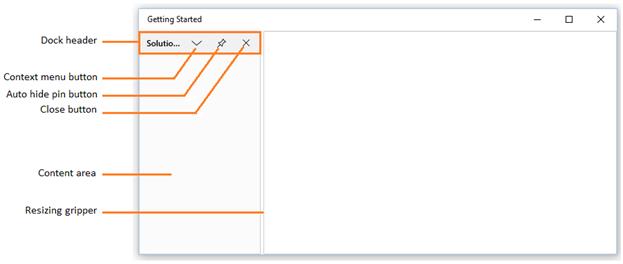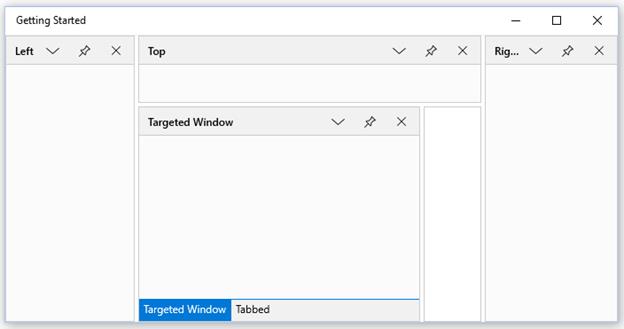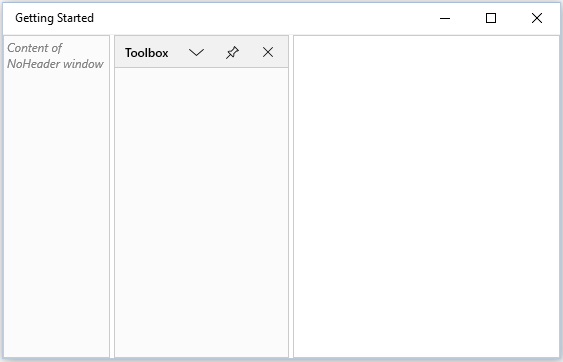Docking Window in UWP Docking (SfDockingManager)
18 Feb 20253 minutes to read
Docking window is one of the state of SfDockingManager. Since Dock is the default value, initially all the children stay as Docking Window.

Configuring Window in Different Sides
The Fives sides where the children can be docked are
- Left
- Right
- Top
- Bottom
- Tabbed
To Dock four children of SfDockingManager to each sides, set SideInDockedMode property with appropriate values.
<layout:SfDockingManager x:Name="docking">
<ContentControl layout:SfDockingManager.Header="Docking Left"
layout:SfDockingManager.SideInDockedMode="Left"/>
<ContentControl layout:SfDockingManager.Header="Docking Top"
layout:SfDockingManager.SideInDockedMode="Top"/>
<ContentControl layout:SfDockingManager.Header="Docking Right"
layout:SfDockingManager.SideInDockedMode="Right"/>
<ContentControl layout:SfDockingManager.Header="Docking Bottom"
layout:SfDockingManager.SideInDockedMode="Bottom"/>
</layout:SfDockingManager>
Docking Window in Various Targets
Docking window can be docked on any side of the Target Docking Window using an AttachedProperty named TargetNameInDockedMode.
To set the child window as TabbedWindow, the window should aware of a Target window name. The following code helps to arrange children of SfDockingManager that targets a single Docking window docked along Left, Top, Right and Tabbed.
<layout:SfDockingManager>
<ContentControl layout:SfDockingManager.Header="Targeted Window" x:Name="DockingWindow1"/>
<!--Targeted to Docking Window1 on Top Side-->
<ContentControl layout:SfDockingManager.Header="Top"
layout:SfDockingManager.SideInDockedMode="Top"
layout:SfDockingManager.TargetNameInDockedMode="DockingWindow1"/>
<!--Targeted to DockingWindow1 on Right Side-->
<ContentControl layout:SfDockingManager.Header="Right"
layout:SfDockingManager.SideInDockedMode="Right"
layout:SfDockingManager.TargetNameInDockedMode="DockingWindow1"/>
<!--Targeted to DockingWindow1 on Left Side-->
<ContentControl layout:SfDockingManager.Header="Left"
layout:SfDockingManager.SideInDockedMode="Left"
layout:SfDockingManager.TargetNameInDockedMode="DockingWindow1"/>
<!--Targeted to DockingWindow to tab-->
<ContentControl layout:SfDockingManager.Header="Tabbed"
layout:SfDockingManager.SideInDockedMode="Tabbed"
layout:SfDockingManager.TargetNameInDockedMode="DockingWindow1"/>
</layout:SfDockingManager>
Enabling or Disabling the Header Visibility
NoHeader is an AttachedProperty, that is used to hide the header of Dock Window. Default value of NoHeader is false. To hide the Header change the value of NoHeader property to true.
<layout:SfDockingManager>
<ContentControl layout:SfDockingManager.Header="Toolbox"/>
<ContentControl layout:SfDockingManager.Header="Solution Explorer"
layout:SfDockingManager.NoHeader="true">
<TextBlock Text="Content of NoHeader window" FontStyle="Italic"
Foreground="Gray" TextWrapping="Wrap"/>
</ContentControl>
</layout:SfDockingManager>
Enabling or Disabling the Dock Functionality
The CanDock AttachedProperty used to enable or disable the docking functionality by setting its value as true or false. By default, CanDock value is true. This functionality can be disabled by setting its value as false.
<layout:SfDockingManager>
<ContentControl layout:SfDockingManager.Header="Toolbox"
layout:SfDockingManager.CanDock="false"/>
</layout:SfDockingManager>